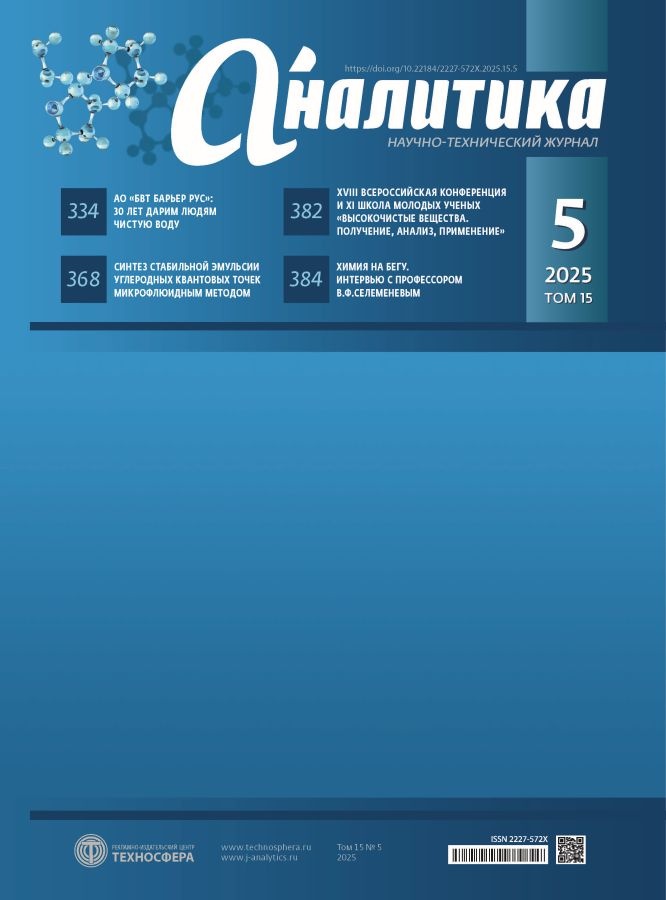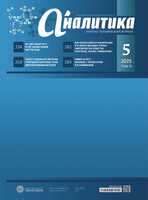Analitika
Scientific and technical peer-reviewed journal
Editor-in-Chief
- Vasilisa B. Baranovskaya, Doctor of Chemical Sciences, Member of the Scientific Council for Analytical Chemistry of the Russian Academy of Sciences
Founder
- Associate printing-and-publication centre «Technosphera»
Publisher
- Associate printing-and-publication centre «Technosphera»
Indexing
- Russian Science Citation Index (RSCI)
- CrossRef
- Google Scholar
- Ulrich's Periodicals Directory
- WorldCat
Frequency
- 6 issues per year
About journal
The main goal of the journal is to form the common information space for science, business and the state in order to create and develop high-tech import independent domestic manufacturing and modernization of the Russian economy.
Current Issue
Vol 15, No 5 (2025)
Modern Laboratory
How to ensure water quality in the laboratory
Abstract
The reliability and accuracy of laboratory tests depend on several factors, including the qualifications of the staff, the condition of the equipment and the quality of reagents. In particular, water used in laboratory testing must meet specific requirements. To ensure that water meets these standards, various methods of purification are used. The article provides a classification of laboratory water purity types, purification methods, storage rules, and proposes a method for optimizing water treatment using the VIKING LAB wash table with a built-in filtration system.
 330-332
330-332


30 years of the BARRIER laboratory – the flagship of water purification systems
Abstract
The Laboratory was established in collaboration with the N. S. Kurnakov Institute of General and Inorganic Chemistry of the Russian Academy of Sciences. Today, it is a large-scale accredited research center consisting of a testing and analytical laboratory, a research center, and an applied research laboratory. The Laboratory staff are highly qualified specialists, including doctors and candidates of science in chemistry, chemical engineering, and biology.
 334-352
334-352


Analytical Methods and Instruments
Integrated solutions for process gas humidity control from JSC EKSIS
Abstract
Process gases are an integral part of modern production. Compressed air, hydrogen, oxygen, argon, helium, carbon dioxide, nitrogen, SF6, natural gas, etc. are used in almost all industries. For the effective use of gases in production processes, it is very important to control their humidity, high-quality preparation and drying. The development and creation of integrated solutions for humidity control, preparation and drying of process gases is one of the areas of specialization of JSC EKSIS, a Russian manufacturer of high-tech control and measuring instruments with more than twenty years of successful experience in the market. The proposed solutions are based on advanced developments: precision humidity meters IVG-1, modern sample preparation systems and highly efficient gas drying units. Integration of this equipment into various technological processes allows solving a wide range of industrial problems. The article describes in detail the technical characteristics of the devices, their advantages and areas of application.
 354-360
354-360


Test systems for detecting residual amounts of host cell DNA and proteins for biopharmaceutical production
Abstract
The results of testing kits manufactured by Hyasen Biotech (China) for detecting residual amounts of DNA and proteins of the producer strain are presented. The study was carried out by the Gamaleya National Research Center for Epidemiology and Microbiology of the Ministry of Health of the Russian Federation (Moscow) in collaboration with GreenVan (Moscow). The article presents testing and validation data for the HCP1046B HEK293 HCP ELISA kit for detecting residual proteins and the HCP1044B HEK293 Residual DNA Detection Kit for detecting residual HEK293 DNA using polymerase chain reaction (PCR). Hyasen Biotech”s reagents for detecting residual proteins and DNA of the producer strain have been shown to provide reliable results for measuring impurities associated with the producer strain, and to be used for routine analysis during the production and release of pharmaceuticals.
 362-366
362-366


Synthesis of a stable emulsion of carbon quantum dots by a microfluidic method
Abstract
The properties, features and areas of application of carbon quantum dots are described. Due to the wide range of radiation and ease of use, quantum dots are promising as labels for visualization of results in test systems. The choice of microfluidic technology for use in test systems is substantiated, its advantages over classical methods are discussed. The algorithm for manufacturing a microfluidic device (MFD) from polydimethylsiloxane by the soft lithography method is described in detail. The synthesis of a stable emulsion of carbon quantum dots is implemented. The optimal synthesis parameters are selected: speed and pressure. The resulting emulsions are analyzed, conclusions are made about the possibility of their use in test systems.
 368-374
368-374


Мнение
Our laboratory’s LIMS contains digital solutions for implementing all aspects of laboratory operations
 376-380
376-380


Выставки и конференции
18th all-Russian conference and 11th School of young scientists high-purity substances. Production, analysis, application
 382-383
382-383


Страницы истории
Chemistry on the run
Abstract
On October 2024, Vladimir Fedorovich Selemenev, a prominent scientist in the field of ion exchange and chromatography, Doctor of Chemical Sciences, Honored Scientist of the Russian Federation, and Professor, turned 85. The life of this scientist, educator, and athlete can be read in his book, Chemistry on the Run: Autobiographical Miniatures, from which we borrowed the title of our conversation. We discussed with Vladimir Fedorovich not only his biography and interests but also touched on issues of concern to chemists: university professors, scientists specializing in chromatography and ion exchange.
 384-396
384-396









